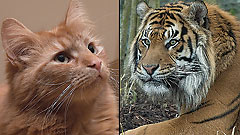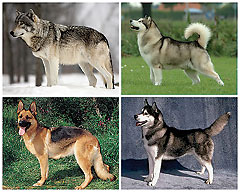Many Americans enjoy the vegetarian lifestyle today, either for health or ethical reasons. Some people choose to extend this dietary philosophy to their pets as well, which has prompted the marketing of commercial vegetarian dog and cat foods. There is a spectrum of foods and ingredients that may be included or excluded from a “vegetarian” diet, depending on one’s definition. At minimum, it usually means that most meat sources are excluded from the diet (such as beef, pork, lamb, poultry, and sometimes fish). More restricted diets exclude other foods of animal origin, such as egg and dairy products. Perhaps the most extreme example would be a “vegan” diet, where all foods and ingredients of foods, including vitamin and mineral sources, are excluded if they are derived from animals. Provided foods are carefully combined in appropriate proportions, vegetarian or vegan diets for people can be very nutritious and healthy. However, is the same true for dogs and cats?
Dogs and Cats Are Carnivores: Humans are omnivores, meaning our bodies can digest both plant material and animal tissue. Dogs and cats are carnivores; they are meat-eaters and aren’t designed to digest plant material efficiently. Dogs are scavenging carnivores; cats are obligate carnivores. Nature designed the bodies of carnivores to thrive on nutrients provided by animal flesh and organ meat. Obligate carnivores (cats) must eat meat to sustain life. As scavenging carnivores, dogs can survive on plant material but they can’t thrive on it alone. To thrive means to grow vigorously – to flourish.
Meat eaters must consume meat to unlock the body’s healing potential, and to provide all the raw materials the body needs to function optimally. Carnivores, including dogs, fed a diet of plant material will not live a long, healthy life, and will have medical and degenerative conditions along the way. When a carnivore is fed a vegetarian diet, or an herbivore like a rabbit is fed a meat-based diet, health problems are the inevitable result.
Some species are better able to eat biologically inappropriate diets than others. However, a very delicate creature like a hummingbird, for example, if forced to eat anything other than its evolutionary diet of nectar, will be dead within a few days. Dogs and cats, on the other hand, are quite resilient. They can suffer a great deal of nutritional abuse and survive; however, their bodies will degenerate over time. 
Unfortunately, many people assume that since dogs aren’t strict carnivores like cats are, they can easily transition to a vegetarian or even a vegan diet; dogs are often referred to as omnivores, which simply isn’t correct. Dogs’ taxonomic classification is Canis lupus, in the Order Carnivora. They are in the same family as their cousins, gray wolves. Just because a dog manages to stay alive on plant-based foods doesn’t make them an omnivore.
The Teeth and Jaws of a Carnivore: Your dog or cat has the teeth, jaws, digestion, and palate of a carnivore. An animal’s teeth are specifically created for the food they are born to eat. Your pet’s teeth are designed to rip, shred, and shear flesh off bone. Dog and cat molars are pointed, not flat. Humans – omnivores – have molars that are large and flat because they’re designed to grind up plant matter. If you look at the teeth of other omnivores and herbivores, you’ll see big, wide, and flat molars designed to chew plant matter.
Your dog or cat has no flat molars because nature didn’t intend for him to eat much in the way of plant matter. They also have powerful jaw and neck muscles that aid in pulling down and consuming prey. The jaws open very wide to accommodate whole chunks of meat and bone, and move only up and down (not side to side), because they are designed for crushing. In contrast, omnivores and herbivores have jaws that permit the lateral (side-to-side) motion necessary for grinding plant material.
The Digestion of a Carnivore : Then there’s your carnivorous pet’s stomach, which is short and simple in design, and also very acidic. It is meant to move food quickly through, and to deal with the pathogens found in fresh whole prey, which is not clean meat. For example, dogs in the wild don’t remove the gastrointestinal tracts of their prey, or the colon. When a cat consumes a whole mouse, they consume the whole mouse.
Plant matter and vegetables need more time to break down in the GI tract, which requires a different, more complex digestive design than your dog or cat’s body possesses. This is also why vegetarian animals tend to masticate or chew their food over and over and over.
The term “wolf it down” refers to the tendency of wolves and other canines to tear chunks of meat off prey and get them into their bellies as quickly as possible. Carnivores don’t engage in much chewing at all. Instead, they rip the food into manageable pieces and down it goes. That’s why whole veggies, grains, and seeds tend to come out in your dog’s feces looking just like they did when he ate them. Since your pet’s stomach isn’t equipped to break them down, they simply travel through the GI tract intact and pass out the other end as undigested waste.
Dogs and cats also don’t make the necessary enzymes in their saliva to begin the breakdown of carbs and starches in the diet. Omnivores and herbivores make those enzymes in abundance, but carnivores do not. Because your dog or cat does not produce cellulase, which is necessary to break down tough fibrous plant cell walls, the pancreas – which is designed to produce an abundance of lipase and proteases to process fats and proteins – has to work overtime to manufacture enough amylase to deal with excessive plant matter in the diet.
Pets produce a small amount of amylase to process the starch found in the prey they consume (cats) and the roughage they selectively forage on (up to 30 percent plant matter, for dogs). Over time, feeding a 100 percent plant matter diet can stress the pancreas, compromising its ability to function properly.
Wild dogs and many wild cats do occasionally consume grass. Wolves and coyotes actually eat an abundance of berries and plant-based material that’s seasonally available, and especially if they’re starving. But their intake of plant material is not constant, and because it’s usually less than 20 percent of their diet (unless prey is scarce), the pancreas can easily keep up with this minimal consumption with no problem.
Your pet also doesn’t produce the strains of gut bacteria necessary to break down cellulose and starch in plant matter. A carnivore’s ability to use plant matter as an energy source is very limited. The small amounts of plant matter wild dogs consume functions as a source of fiber (roughage), phytonutrients, and antioxidants, but not usable energy.
The Palate of a Carnivore: Most dogs and cats don’t care for the taste of vegetarian pet foods, which makes sense, since they’re carnivores. The reason pets are willing to eat a primarily grain-based or vegan commercial pet food is because most of these diets are well-seasoned with flavor enhancers. For example, after kibble is produced, it’s sprayed with a topcoat containing a palatability enhancer to entice pets to eat it. There are also meat- and poultry-flavored digests made from animal byproducts that can be sprayed on. This means that even though it’s a vegetarian or vegan pet food, the topcoat often is not. The topcoats don’t add any nutritional value; they simply entice your pet to eat a biologically inappropriate food. Just because your dog or cat gobbles up a flavor-enhanced pet food doesn’t mean she’s being nourished in a way that will sustain their health long-term.
Part 2 next month will discuss the importance of animal protein in the diet of cats and dogs, and the nutritional deficiencies that can be caused by vegan and vegetarian diets. |